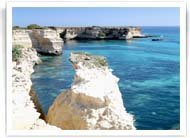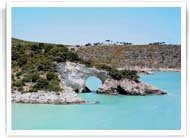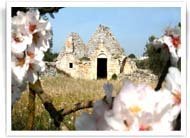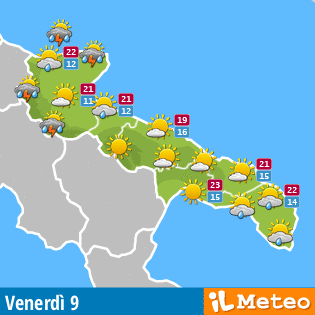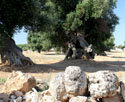APULIA: nature, tradition and culture
A guide to learn how to experience and love Apulia
Apulia: an amazing travel in a region marked by a winding nature which appears as a one thousand colors mosaic. Ancient traditions meet the flavour of the land. A plot of art, history and culture joint to the beauty and the naturalness of the places let the tourist experience a rich holiday falling in love with this territory. Crystal clear sea, breathtaking coasts, immense secular olive-groves, caves and gravine, trulli and farms, churches and ancient villages: from Salento to Gargano they are the ingredients of a fascinating adventure.
Salento: land of sun, sea and ancient traditions
The Salento is characterized by important old town centres such as the one of Gallipoli, Ostuni, Martina Franca, Lecce, Taranto, Manduria, Nardò, Francavilla Fontana, Oria, Otranto, Grottaglie. They are marked by numerous rocky churches and Basilian crypts frescoed with holy imagines and used as places of worship during the Middle Ages. We can admire valuable Roman cathedrals and experience ancient rituals and traditions as well as appreciate precious handmade products realized by ancient peoples such as the Messapi who had inhabited these territories for centuries. The Salento is famous all over the world for its Baroque which developed at the end of the 16th century.
Gargano: rich nature, cliffs and beaches, seafaring villages and holy site
Gargano: a mountain rich of charm, a world where the clock seems to have stopped. Ancient maritime centres alternate with indented coastlines sheer to the sea and large woods full of firs, beeches and Turkey oaks. It could be considered a real patrimony thanks to its historical, natural and spiritual richness. A land where we can see the signs of a millenarian history and appreciate its natural, historical and religious heritage.
Valle D'Itria: an immense artistic and naturalistic treasure of the territory
Among the provinces of Bari, Taranto and Brindisi develops the karstic Valle d’Itria: a sweet land characterized by numerous dry walls where the olive trees alternate with oak tree woods and the view is enriched by the cone-shaped roofs of the trulli. Here we find some of the most beautiful and typical villages of the region, deep in this natural masterpiece, such as Martina Franca, Alberobello, Locorotondo and Cisternino, which surely awaken the tourist’s interest.
Rituals and traditions
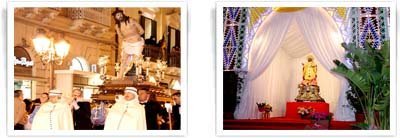


The sanctuary of Padre Pio calls devotees from all over the world
Numerous devotees visit the 16th century convent of the Cappuccini, where Padre Pio had lived for 50 years. The new church dedicated to San Pio has been built to give hospitality to thousands of pilgrims that every year come to honor the memory of Padre Pio from Pietrelcina.
An evocative sanctuary in the Archangel’s cave
The old town centre develops around the Archangel’s Cave built between 490 and 493 A.D., following the apparitions of St. Michael the Archangel to San Lorenzo Maiorano, bishop of Siponto.

 Home PUGLIA
Home PUGLIA Places to visit
Places to visit Sea places
Sea places Ancient villages
Ancient villages Salento
Salento Gargano
Gargano Tremiti Islands
Tremiti Islands Valle D'Itria
Valle D'Itria Lecce Baroque
Lecce Baroque Holy sites
Holy sites Olive groves
Olive groves